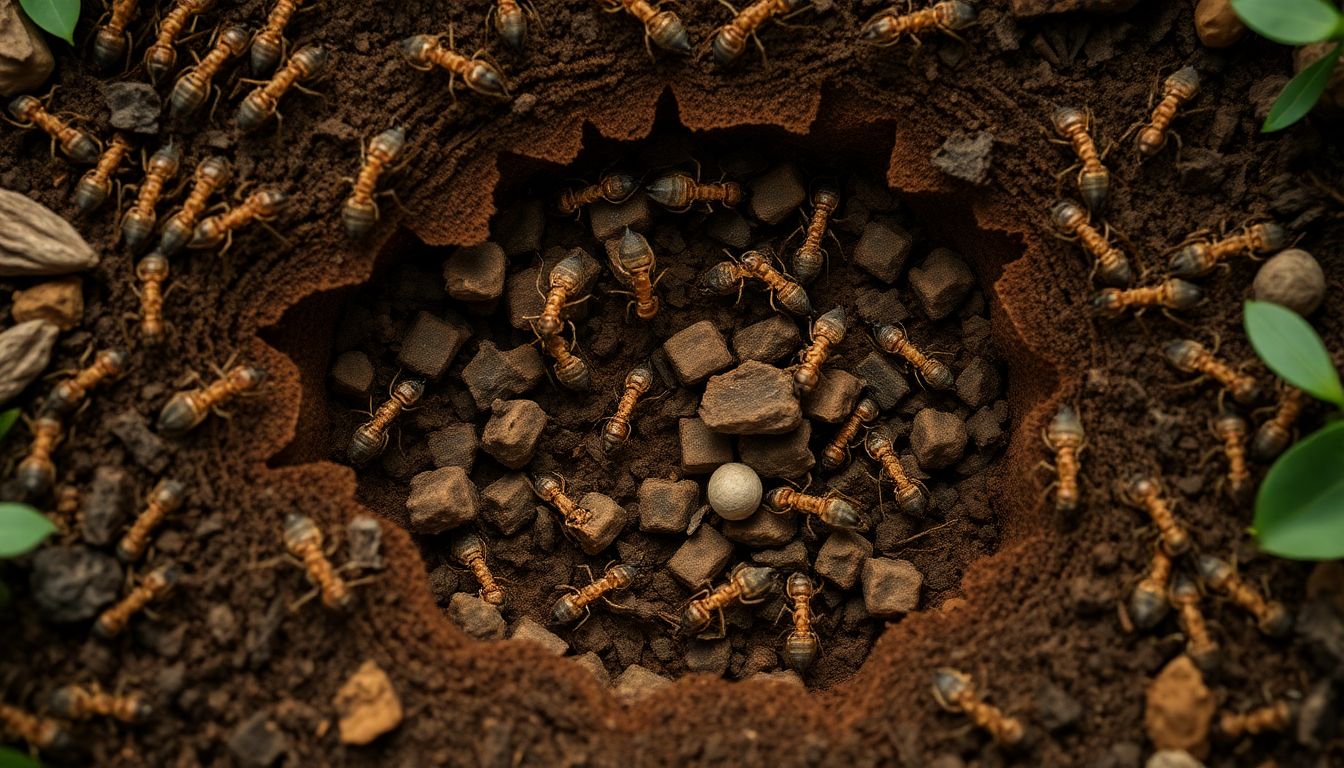
The Social Lives of Ants: How Tiny Insects Achieve Giant Feats of Teamwork
Imagine an army of ants, working together to carry a crumb of bread many times their size. It's not just brute strength. It's also complex communication and teamwork. Social insect behavior, like what we see in ant colonies, is important. It shows how cooperation can lead to big achievements. We'll look at how ants work together and organize their societies.
Understanding Ant Societies: Caste Systems and Roles
Ant colonies have different roles. They are organized in a system. Each ant has a job to do for the colony's survival. Let's break down the roles of ants and their caste systems.
The Queen Ant: The Foundation of the Colony
The queen ant is the heart of the colony. Her main job? Reproduction. She lays eggs to grow the ant population. A queen can live for several years and lay millions of eggs. She is the foundation for a thriving colony.
Worker Ants: The Backbone of the Operation
Worker ants are all female, and they're busy! They do almost everything. This includes foraging for food, taking care of young ants, and building nests. They also defend the colony. Each worker has a task. It's a division of labor that helps the colony run efficiently.
Soldier Ants: Protectors of the Colony
Soldier ants are the colony's defense force. They are often larger than worker ants. They have strong jaws. Their job is to protect the colony from danger. Some soldier ants have specialized roles, like blocking nest entrances or attacking invaders.
Communication Strategies: How Ants Share Information
How do ants coordinate their actions? It's all about communication. Ants use various methods to share information. These include chemical signals, touch, and even sound.
Pheromones: The Chemical Language of Ants
Pheromones are a key part of ant communication. These chemical signals do many things. They mark trails to food, signal danger, and help ants recognize each other. It's like a complex language spoken with scents.
Tactile Communication: Antennae and Physical Contact
Ants use their antennae to communicate. They touch each other. This helps them share information about food and colony status. It is also used for social interactions. Antennae are important for an ant's daily life.
Stridulation: Sound-Based Communication
Some ants can make sounds. They do this by rubbing body parts together. This is called stridulation. They often use it underground. It is used to communicate in the dark.
Teamwork in Action: Examples of Ant Cooperation
Ants are masters of teamwork. Their coordinated actions lead to amazing feats. Here are some examples of ant cooperation.
Cooperative Hunting: Overpowering Prey Many Times Their Size
Ants often hunt together to capture large prey. They coordinate their attacks. They overwhelm prey much bigger than they are. Army ants are a good example. They work together to take down insects and small animals.
Nest Building and Repair: Engineering Marvels
Ant nests are complex structures. Some species build underground tunnels. Others create nests in trees. The nests include leaf nests. Ants cooperate to build and maintain them. It's an engineering marvel.
Raiding: Resource Acquisition Through Organized Theft
Some ants raid other ant colonies. They also attack insect nests to steal food and resources. These raids are organized. They involve many ants working together. It shows how ants compete for resources.
The Evolutionary Advantages of Social Behavior in Ants
Why are ants so social? It's all about evolution. Social behavior gives ants many advantages.
Increased Survival Rates: Strength in Numbers
Living in a colony improves an ant's chance of survival. They work together to defend against predators. They also gather food. Strength in numbers provides protection and resources.
Efficient Resource Utilization: Optimizing Foraging and Nesting
Ants use resources efficiently. They forage in organized groups. They optimize their nesting sites. This helps them thrive in their environment.
Adaptation to Diverse Environments: Thriving in Varied Ecosystems
Social behavior helps ants adapt to different environments. They live in deserts and rainforests. They survive in cold climates. Their social structure lets them thrive anywhere.
Threats to Ant Colonies: Challenges to Social Harmony
Ant colonies face many challenges. Environmental changes, invasive species, and diseases threaten them.
Environmental Changes: Habitat Loss and Climate Change
Habitat loss and climate change impact ant populations. These changes disrupt their social structures. It makes it harder for them to survive.
Invasive Species: Competition and Disruption
Invasive ant species can disrupt native ant communities. They compete for resources. They alter ecosystems. This can harm native ant populations.
Parasites and Diseases: Internal Threats to the Colony
Parasites and diseases weaken ant colonies. These internal threats compromise their social harmony. It makes them more vulnerable to other threats.
Conclusion
Ants' social behavior and teamwork are fascinating. Understanding these complex systems is important. They show us how cooperation leads to incredible achievements. What can we learn from the social lives of ants? Perhaps that working together, even as tiny individuals, can move mountains.











0 Comments